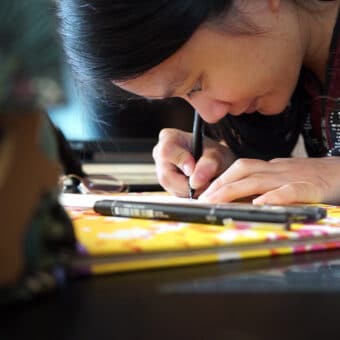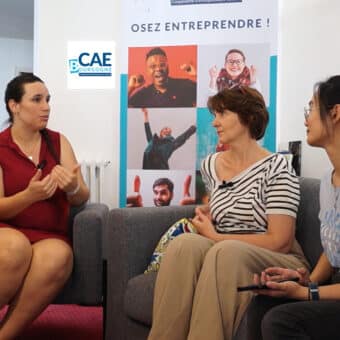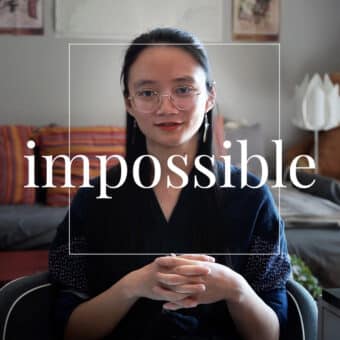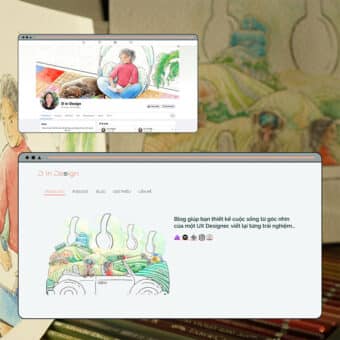This article is NOT about loneliness due to isolation!
The afternoon when loneliness drowned me
I couldn’t keep my promise.
It was Tuesday, February 28, 2023, the Tuesday that just passed. I was all motivated to finally free up 30 minutes in my jam-packed schedule to write and send the very first Creati’letter, my monthly newsletter that I launched 2 weeks ago.
But right away, I felt tense when I saw that a bot spammed the subscription of my newsletter, with 600 new subscriptions, or rather, 600 false subscriptions. I had the impression that these were stolen emails. I immediately imagined that these recipients were reporting me directly as a spammer, by receiving my welcome email, sent automatically to each subscription.
A reputation is more easily destroyed than built. The 30 minutes planned for Creati’letter turned into 2 hours of searching for a solution with panic rising in my brain.
I searched on Google. There were only solutions for people who receive unwanted emails. There were no solutions for those on the other side of the fence, those who send and get flooded with an unwanted email list.
I looked for the answer in my networks of entrepreneurs and illustrators. I received a few words of encouragement, but no resolution.
I’ve been looking for an expert on MailerLite, the tool I use to send emails. This time, I came across a ton of articles presenting the tool, comparing services, and installation tutorials.
The bot kept signing up to Creati’letter every 10 minutes with a new email address. The irritation and the incomprehension were strangling me little by little.
It was ruined for my first newsletter that I had promised to my community. I felt alone in the world, stuck in a hole filled with email addresses.
The punch of loneliness
I rarely feel lonely. In the past year and 4 months of independent activity, loneliness has only knocked on my door about five times.
But each time, it felt like I was punched in the head by an MMA champion. It was surprising and violent.
Contrary to popular belief, this loneliness is definitely not because I work alone from home.
For an introvert with a world built in her own imagination like me, working alone in a comfortable, home-like environment is the perfectly fertile condition for my creativity, productivity and serenity.
So why do I happen to feel profoundly alone?
The gap between the daily life of an creative freelancer and their entourage
Because it is hard to externalize our problems
Often, when we meet a colleague at the office coffee machine, all it takes is a sigh and a sentence for the colleague to understand our problem. Since the colleague works in the same environment, he or she knows the sector, the context, there is a good chance that he or she is aware of the current problems, and that he or she knows the people we are talking to.
And even if the person in front of us is not a colleague, he or she can easily sympathize with us when we say: “My boss requires me to write down the arrival and departure times every day!”
Whereas when a creative freelancer expresses these worries to his or her non-entrepreneurial entourage, he or she has to tell the whole context, the stakes, the solutions tested, so that the other person can understand.
When you’re in the grip of emotions, as I was on that Tuesday afternoon, it’s almost impossible to express your problem in a brief and simple way.
Because our problems are sometimes considered illegitimate
This is the case when we start to express our difficulties, and we receive the remark: “But you make a living from your passion, don’t you? You’re free, compared to us employees, who are stuck with a manager, an office, and morning traffic. Why are you still grumbling?”
From time to time, some people even tell us, “Ah well, the artist has finally figured out that life isn’t all roses! You’re getting caught up in reality, aren’t you?”
Whether it’s a joke or a real judgment, these remarks happen very often to independent creatives, whose viability as a business is still considered utopian or elitist. By receiving these reproaches all day long, creatives feel less and less legitimate to express their worries or doubts.
The gap between the spectator and the creator
As the result of a creative freelance’s work is usually visible and public, some people around us think they understand the whole creative profession.
Expectations that amplify doubts
The question that comes up very often at every family dinner or outing with friends is ” So, does it work?”
In the era where many creators come along and seem to accomplish overnight success thanks to the internet, sometimes those around us become impatient.
That’s why we get questions like “What do you do all day? How come you don’t have any new drawings?” “Why don’t you make more videos?” “Why don’t you post a blog post every week?”
But in the case of a creative freelancer’s life, creating is just the top of the iceberg. On the other side, there is prospecting, contract negotiation, administration, accounting, billing, partner network development, learning and maintaining technical and creative skills…
And the “creation” part is itself an iceberg!
When the viewer sees a blog post, they may think that all it takes is to write, add the photos, and post, like a Facebook post.
Whereas a blog post like mine requires:
- Reading articles on the same topic to try to approach the theme from a new angle
- Searching for references to reinforce the arguments
- Writing, building a structure that respects SEO criteria
- Translation (into English and Vietnamese)
- Proofreading (most of the time, by my editors)
- The creation of photos, montages, illustrations, or the search for examples to illustrate the ideas.
- The treatment of the photos to facilitate the display on the blog
- Pre-publication layout
- The publication
And even to publish, here are all the steps I have to complete before the article is visible on this blog (and as I write in 3 languages, the process has to be repeated 3 times.):
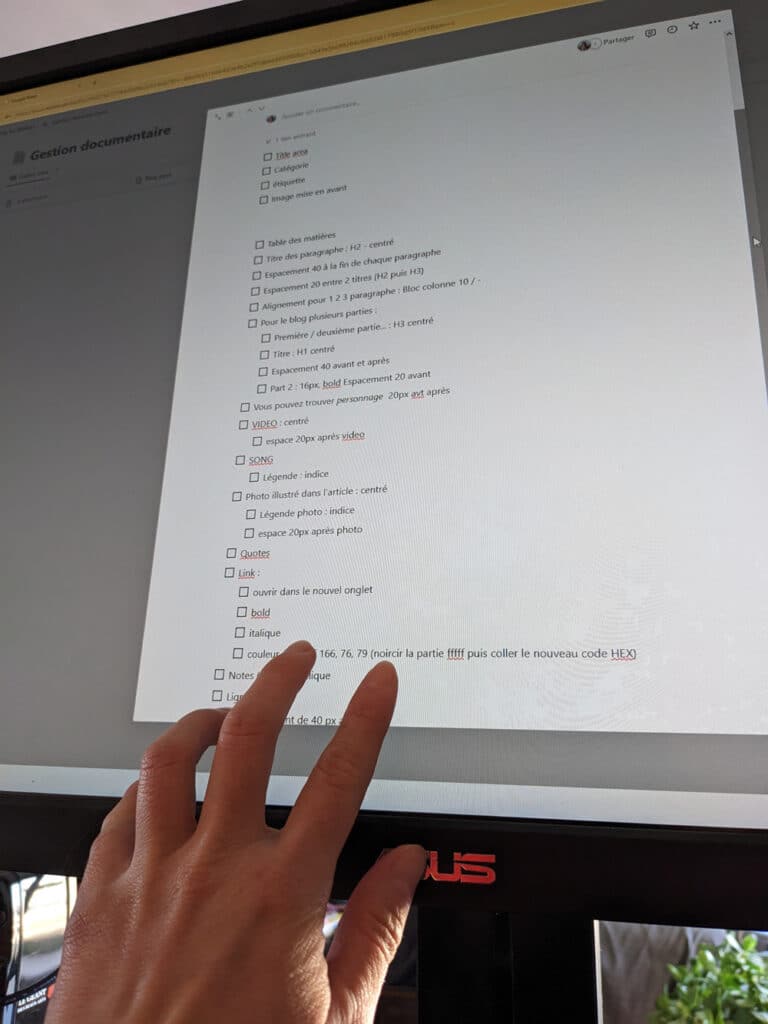
Not all freelancers are aware of the amount of work they put into each video, each blog post, each drawing, or each song, since it is a job of passion. So when asked by their entourage, they can only answer: “Uh… You know, it really takes a lot of time…” and then doubt themselves about their ability and productivity.
The non-applicable advices
Since there are more and more successful creators sharing their behind-the-scenes stories, it happens that people around us give us solutions applied by these artists, before understanding all the elements that lead to their successes.
“All you have to do is draw portraits of big influencers and tag them on Instagram to get more exposure and clients!”
“You need to move to Paris, where there are big studios to get a contract.”
“Why don’t you crowdfund to self-publish your book?”
These are all good tips. But they’re not applicable to every creative.
When advice comes from a good intention, it’s hard to explain why you can’t (or won’t) apply it, without offending the person, or without going into explanations of situation and strategy that can take up to 15 minutes.
For example, for the question about self-publishing, the author-illustrator Cy. has made a very complete explanation video (for those who speak French). It’s clearly difficult to explain all these aspects without turning a conversation between friends into a course on publishing, or into an unwanted debate.
Loneliness does not appear because I work alone…
“You work alone in your corner, so of course you feel lonely. Do you talk to other living things other than your cat in your day? Do you get out of your house every day? How long has it been since you’ve seen new people?”
That’s what a friend told me, right after I confessed to him that I felt lonely, stuck in a hole filled with unsolicited email addresses.
All I felt when I heard that remark was… loneliness.
With work meetings, client calls, and training, of course I talk to other humans every day.
Between shipping artwork, client meetings, book events, workshops, appointments with consultants, grocery shopping, sports, I definitely have to get out every day.
Last week, I just met at least 5 entrepreneurs I didn’t know at an event for freelancers in the region. Next week, I’ll be going to my city’s Drink and Draw, where I’m sure to meet at least 5 new illustrators. As opposed to when I was employed, with the humdrum of my daily grind, it took 3 months for me to meet 10 new people.
The loneliness doesn’t come from working alone.
Loneliness comes from the inability to share my difficulties, my doubts, my fears with the people I love the most.
How to ease the creative freelancer’s loneliness
If the loneliness comes from the gap between your entourage and yourself, it always risks to come back, since the more you advance, the bigger the gap will be (unless you completely change your entourage, but it is certainly not my wish…)
As I said above, in 1 year and 4 months, I only felt lonely 5 times, at most. The onset of loneliness hurts as much as a punch from an MMA champion, but it never knocked me out.
If I always manage to get up quickly in the ring, it’s because of these 3 pillars:
1. People who listen and accept my problems
I have 3 people to whom I share all my creative ideas, in complete confidence. I feel lucky and grateful that they are the ones to whom I can also tell my most extravagant, silly, or fuzzy worries. Whatever the problem is, they have never illegitimized it to me.
Sometimes they help me directly to find a solution, or an expert on whom I can rely. Other times, they are just there, physically or by phone, for a hug that helps me get my head back on straight.
2. The advice of people who have a global vision of entrepreneurship or creative life
I still remember my anxiety during the meeting with my Job Centre (Pôle emploi in French) advisor, 6 months after I left my former job. I was afraid of the question “How come you don’t have any clients, when it’s already been 6 months since you started your business?”
Against all odds, she told me, “You managed to build your website, launch a blog, analyze the market, build the offerings, identify potential clients and join a cooperative in 6 months? But… you move fast!”
Most people don’t know that it’s pretty common for a freelancer to not be able to pay themselves in the first few months of their business. And among those people, I include “us”, the creative freelancers.
My Job Centre advisor explained to me that a freelancer in my field needs on average 12 to 18 months to start being profitable. She also reassured me that most freelancers need 9 months to finalize all the steps I accomplished in 6 months.
Since this superb consultant couldn’t accompany me any longer, I found two other experts to support me in my creative freelancing adventure. They are Pierre Bourzama, a consultant from the CAE Bourgogne cooperative, who has accompanied several generations of entrepreneurs in various fields, and Chi Nguyen, a PhD in education, an author, a blogger, a podcaster and a YouTuber.
3. The magic question
“Will this worry, which makes me feel so alone, continue to bother me 10 years from now?”
In most cases, the answer is no. Either because the worry seems so trivial on the 10-year scale, or, because I’m sure that I’ll find the solution before the next week, month, or year.
And so, this loneliness will go away.
How to support a creative freelancer?
Obviously I’m not writing this article to say, ” Boo, boo, we feel alone because our loved ones don’t understand us, we are such misunderstood artists!”
Most of the time, the people around us are worried about us, or impatient, or just curious, with plenty of good will.
So, if you have a creative freelancer in your entourage, and you want to check up on them, or help them, without seeming intrusive, there are 3 simple and effective ways:
1. «Is it going the way you want it to?»
This question is much nicer to receive than “So, does your thing work?”
The question remains fairly open-ended and allows the freelancer to share with you what those desires are, where they are at, and what those current problems are.
2. Listen to them and accept their problems
If the freelancer starts talking about their problems with you, it is because they trust you and need your support.
The best gift you can give them is a confident, non-judgmental space.
Sometimes, externalizing the problem is all the freelancer needs to get their head back on straight.
3. «How long have you had this problem? What solutions have you tried?»
Even if you are eager to help the freelancer no matter what, before you rush to give advice, and ask why the freelancer didn’t try this or that solution, ask the questions to understand the context, and the paths they went through.
Often, in the rush and panic, the creative freelancer can lose sight of their big vision. Answering these questions will help them put all the pieces of the puzzle together.
Sometimes they will find the solution on their own, after regaining the big picture, thanks to your questions, your listening, and most of all, thanks to your kindness.
And me, now that the loneliness is gone, I am sure that I will quickly find a solution for this newsletter issue! Creati’letter is coming!
Keep creating!
Tu Ha An
*Please consult the information on Copyright & Intellectual Property before copying or mentioning the content and images of tuhaan.com




